Guest Post – from Janis Bookout
Janis Bookout is an Austin EcoNetwork climate blogger. She is “Jack of All Strategy” at 2020 or Bust, a citizen’s climate initiative dedicated to closing the 8 billion ton carbon emissions gap by 2020 and putting the world on track for ending the climate crisis in time. She is also the Outreach Manager for Earth Day Austin.
Earlier this week Austin hosted one of the coolest conferences I have ever attended — the co-located Smart Cities Innovation Summit and The US Ignite Global Cities Team Challenge Summit. Our own Mitch Jacobson of the Austin Technology Incubator was a supporting partner in producing the event and did a fabulous job.
The Smart Cities Innovation Summit brings together more than 100 cities and their leaders to create a collaborative environment for sharing best practices and solutions to cities’ biggest needs and opportunities. The Global City Teams Challenge is an initiative to help move forward the implementation of Internet of Things technologies within the context of smart communities. Main topics included infrastructure, city networks, gigabit networks, resilience, mobility, governance, and energy.
As someone who has devoted their life to the end of the climate crisis, I became more and more excited as I listened to the keynotes and made my way through the expo floor. It became increasingly clear to me that “smart cities” have an enormous advantage over other cities when it comes to making environmentally responsible policies and management decisions.
Municipalities are the leaders in climate change. The city leaders I met are desperate for ways to enhance their energy efficiencies, decrease their carbon footprints, and implement the biggest environmental improvements possible at the highest rates possible.
What companies are doing is exciting as well. For example, Current by GE uses the Internet of Things to improve performance of energy-saving technologies. Companies offering air quality sensors are plugging into Internet of Things technologies to allow departments of transportation to redirect drivers. Networked sensors can help manage parking and traffic lights to reduce idle times. The possibilities seem endless. And from what I see, the demand is obvious. City leaders are hungry for these innovations.
What was also very heartening was to see the many inspiring city projects that participated in the challenge. I heard one of my favorite stories at a panel discussion on “Advancing Sustainable Energy Communities.” Sheri Borrelli, from Energize Connecticut, shared that 95 percent of the 200+ cities and towns participating committed their municipal buildings and schools to reducing emissions by 20 percent by 2020. Of course, I love the year 2020, because of the under-promoted urgency of closing the 8 gigaton emissions gap by 2020 in order to keep global warming under 2 degrees.
I could go on and on. But one thing is for sure – this was not that kind of conference where people just sat there, listened, and patted each other on the back. Deals were being made and actions were being taken that will most certainly advance environmental solutions. The winds of change are certainly blowing, and I for one, am glad to get a whiff of it.



